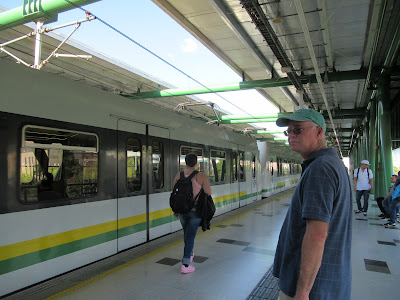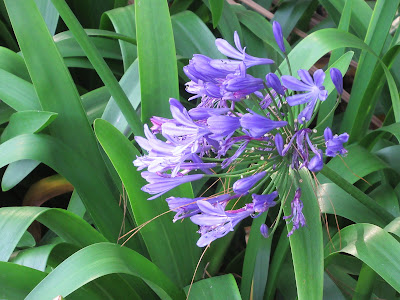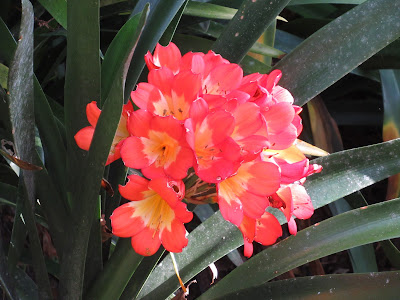We had been "city dwellers" for three weeks when we met up with new friends, Margaret and Dan, who were vacationing in Colombia. While Medellín has many beautiful sights, I was feeling the need to exchange the busyness of the city for some calmness of the Colombian countryside. A day trip to the colorful pueblo (small town) of Guatapé was just what I needed. And for those of you who are enduring another winter storm, I hope that this "shot of color" will help you remember all the beauty that lies underneath yet another foot of snow.
Guatapé is a popular tourist destination located two hours from Medellín. It sits beside a vast, man-made reservoir that provides access to many outdoor activities. In order to get there, one has to drive up and over the mountains that surround Medellín on a very scenic but narrow and twisty road. Best to leave the driving to the expert Paisas, so we took one of the many tour buses for a full day of Colombian countryside beauty. Our tour through Tours Guatapé, proved to be quite a bargain. The $25 usd cost included transportation in a comfortable bus, a "tipico" Colombian breakfast and lunch, and interesting stories by our guide, Jesus. With a name like that, we were assured of a ¨heavenly" day!
Quaint roadside cafés line the road to Guatapé, and we enjoyed spectacular views as well as tasty food during our first stop for desayuno (breakfast). It was no surprise that arepas con queso and hot chocolate were on the menu. Colombians LOVE their arepas! And Doug and I have to agree that these were some of the best that we have tasted during our time here. Continuing on, we enjoyed views of lush green landscape as our driver expertly maneuvered the bus on the narrow, twisty road alongside trucks, cars, motorcycles, and bicycle racers in training that shared the road. Our next stop was the cute pueblo of Marinilla.
 |
| Photo credit: Margaret Elvekrog |
Continuing on our journey, we began to see bodies of water that are a result of the large hydroelectric dam that was erected in the area in the 1970s. As we passed through the city of El Peñol, Jesus filled us in on the history of this pueblo. In 1978, the construction of the dam and resulting reservoir flooded the low lying lands of El Peñol and forced the people to relocate their homes, businesses, and community. Today, the statue of the Phoenix in the city square of El Peñol reminds all of how this new town has "risen from the water" and rebuilt itself in even greater splendor.
As our journey continued, we turned the corner to see the magnificence of La Piedra del Peñol. This granite rock is the third largest in the world and the largest one that (almost) anyone can climb up. How, you ask??
Why, take the stairs, of course!
For a $6 usd admission fee, we ascended up the 700+ stairs to enjoy amazing views ... and a refreshing Michelob beer "Colombian style"... with mango, lime and salt when we reached at the top.
We were quite hungry after that Herculean feat, so Jesus called out, "Vámonos ... let's go!¨ We were treated to almuerzo tipico (typical lunch) complete with traditional Colombian music at a cute outdoor café just down the road in Guatapé.
After our lunch of chicken or fish, rice, beans, avocado and platano, Jesus lead us on a walking tour of this cute pueblo. Guatapé has prospered through the years due to the jobs generated by the nearby hydroelectric dam. But with its close proximity to the waters of the giant reservoir, Guatapé has also developed into a popular tourist destination.
With encouragement from the government, the citizens of Guatapé have preserved the beautiful architecture of the past. At the same time they have promoted tourism with the development of numerous shops, hotels, restaurants, and just plain ¨cuteness¨ that line their streets.
 |
| Photo credit: Margaret Elvekrog |
Colorful works of art known as zócalos (or facades) decorate the lower walls of the houses and businesses in town. A zócalo may tell the history of the building or town or display the interests of the home or business owner. To us, it was a colorful treat for our senses!
After an hour long walk around the town, I realized that there was so much more beauty to take in then we could possibly do in one afternoon. It is easy to see why Guatapé has developed into such a popular tourist destination! For me, it was the perfect place to slow down for a day and enjoy the colorful yet serene beauty that is typical of the pueblos of Colombia.
Until next time ... Color Your World With Beauty ... and enjoy the adventures in your life!
















































